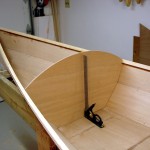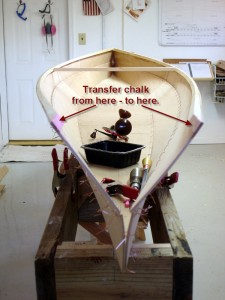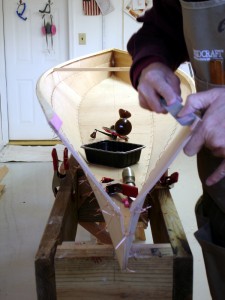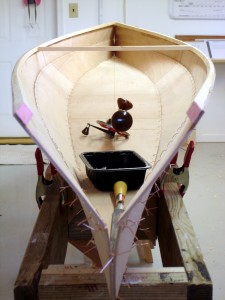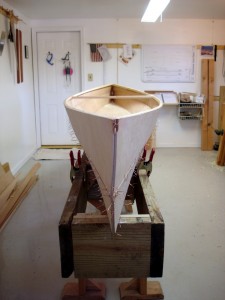The aft bulkhead doesn’t fit as well as I would like, probably a consequence of the lofting error that kept the garboard plank from joining the bottom well. When the bulkhead’s bottom edge is flat against the bottom, the top does not rise high enough. When lifted up, the top section fits very well but leaves gaps below. Some builders of stitch-n-glue boats would suggest using it anyway. Just wire it so the top meets the sheers and fill the bottom gaps with thickened epoxy. It will be reinforced with fiberglass tape anyway. I figure that structural members ought to fit well, so I’m not happy with the gap filling suggestion. I remade the part.
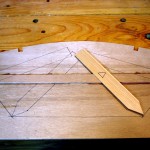
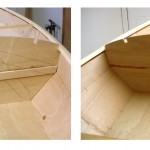 Of course, there was not enough left over plywood for the complete part, only enough for the bottom half. OK, lets cut and butt join. How should that spliced on piece be laid out accurately? The corners are the critical point and there are only four. The other lines can be constructed if they are accurately marked. Ah-ha, a quickly made pointing stick will do the job. I’ve seen some complex shapes defined with pointing sticks. I inked the lines on the back (never seen) side of the bulkhead to show you the technique. The builder’s triangle on the stick was not for the usual up / down, but to show which surface is visible, eliminating any error due to the point not being precisely centered. (See, precision is not essential in all layout tools.)
Of course, there was not enough left over plywood for the complete part, only enough for the bottom half. OK, lets cut and butt join. How should that spliced on piece be laid out accurately? The corners are the critical point and there are only four. The other lines can be constructed if they are accurately marked. Ah-ha, a quickly made pointing stick will do the job. I’ve seen some complex shapes defined with pointing sticks. I inked the lines on the back (never seen) side of the bulkhead to show you the technique. The builder’s triangle on the stick was not for the usual up / down, but to show which surface is visible, eliminating any error due to the point not being precisely centered. (See, precision is not essential in all layout tools.) 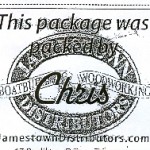 The rest is a matter of waiting for epoxy to cure, cutting to the new lines and trimming to fit more snugly than the original part.
The rest is a matter of waiting for epoxy to cure, cutting to the new lines and trimming to fit more snugly than the original part.
Jamestown Distributors provided a ship date well off into the future when I ordered the hatches and some other things from them. Then, they beat that estimate by well over a week. Exceeding expectations is always a good way to keep customers happy.
The bulkheads close off the ends of the boat, forming watertight flotation chambers. Many people also use these areas for storage of the things they take along on their canoeing adventures. Access can be by hatches cut into the deck, or by hatches cut into the bulkheads. 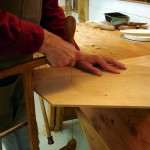
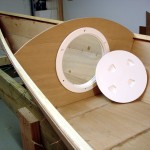 The true voyager likes the deck hatches for frequent and easy use. We won’t be using our canoes for voyaging, so the much simpler bulkhead hatches will do just fine. Round “deck plates” are the solution of choice for bulkhead hatches.
The true voyager likes the deck hatches for frequent and easy use. We won’t be using our canoes for voyaging, so the much simpler bulkhead hatches will do just fine. Round “deck plates” are the solution of choice for bulkhead hatches.
My turning saw, a bird’s mouth bench accessory, and a rasp made the work easy.
It’s a shame I don’t do videos. You would have enjoyed watching me reassemble the turning saw after inserting its blade through a pilot hole in the bulkhead. With tension loosened, a turning saw is an extremely loose collection of parts, and a human does not have enough hands to keep the parts together while reassembling it “in space.” Hint: use a little piece of masking tape to hold one end of the blade in its socket, and a short piece of string tied loosely around the toggle to keep it were it belongs.
